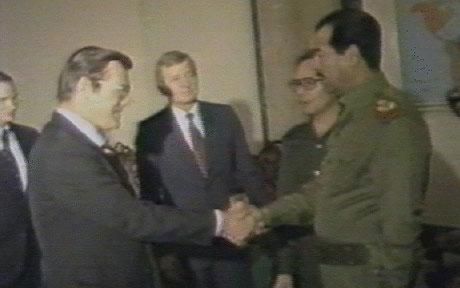Features
You are here
The real story of the Iran-Iraq war, 1980-1988

August 23, 2012
A terrible war convulsed Iran and Iraq from September 22 1980 until August 20 1988. In that war, around a million people were killed and two million were made refugees. The fighting seemed to many observers to be a replay of World War One, with Iran sending its young soldiers to their death in “human wave attacks,” and Iraq responding by using chemical weapons including mustard and phosgene gas.
When the war was over nothing had changed. Both countries returned to the borders from which the war began. Between them, they had spent $350 billion on this senseless slaughter. According to Ruth Leger Sivard, a brilliant anti-war activist in the United States, that amounted to more than all the countries of the Third World spent on public health in a decade.
Revolution and counter-revolution
The war happened just one year after 1979 revolution which overthrew the hated US-backed Shah of Iran. That revolution was a genuine popular uprising, an uprising which included a massive radical student left, and workers, especially in the oil industry, taking over control of production from their managers.
But this revolution was hijacked by one section, represented by Ayatollah Khomeini, which proceeded to install a regime of extreme social conservatism, and extreme repression. Thousands of union activists and revolutionaries were sent into exile, into prison, facing torture and often death, in a counter-revolution from which Iran has only slowly started to recover.
The Iran revolution infuriated the United States, but not because of the torture and executions. After all, their former ally, the deposed Shah of Iran, was infamous for the role of his dreaded secret police, the Savak. According to Time magazine, in 1979, Savak’s 60,000 agents had “tortured and murdered thousands of the Shah’s opponents.”
What infuriated the United States was the fact that the new regime was openly opposed to US domination in the region, while the Shah had been the biggest ally of the US.
In its commitment to restore its influence in the region, the United States played an extraordinarily deceitful, dangerous and reactionary game throughout the next decade.
Iran had its own reasons for confronting Iraq. An external enemy was useful in distracting the population at home from the increasingly reactionary politics of the Khomeini regime. And Iraq had its own reasons for attacking Iran in 1980—the two countries had been rivals for years, with a series of border disputes leading to periodic acts of violence.
But it was always going to be risky for the very small country of Iraq—population at the time of just 15 million—to challenge the much bigger Iran with more than 40 million people. Iraqi leader Saddam Hussein was calculating that in the chaos resulting from the revolution, Iran would not be in a position to resist a lightning invasion, and that he could expand Iraqi access to key shipping routes in the Gulf. Some think he was egged on by the United States. This has yet to be proven. But, it was significant, according to one highly placed observer, that there was “no explicit red light” from the US directed towards the Iraqi ambitions.
Once the war began, the U.S. did everything in its power to see that it was long and destructive.
US intervention
Officially, it was a mortal enemy of the Iranian regime, which had, after all, presided over the hostage-taking of 60 US citizens, held captive until 1981. But behind the scenes, the US was working to see if it could pull Iran back into its sphere of influence.
According to an official US inquiry called the Tower Commission, the United States in 1983 provided information to the Iranian regime, leading to the mass arrests and executions of thousands of left-wingers in the country.
But the principle investigation of the Tower Commission was not that horrendous crime, but the 1985-1986 scandal of the United States—officially neutral in the war—secretly shipping massive quantities of arms to Iran, and using the money gained to fund the right-wing “contras” in Nicaragua. The resulting “Iran-Contra” scandal almost led to the collapse of the presidency of Ronald Reagan. The arms gained by the Iranians were one factor in their 1986 surprise offensive which severely damaged the Iraqi military.
The Iran-Contra scandal shocked the Arab states in the region which were client states of the United States. To demonstrate to these mostly right-wing and reactionary states that the US was still their best friend, Reagan flipped from secret support to Iran to massive support for Iraq. The US navy deployed the biggest armada since the Vietnam War, and with its support, the Iraqi army began to turn the tide of war.
The very rapid US military buildup had tragic consequences, including the shooting down, by the US, of a civilian Iranian airliner, the Vicennes, killing all 290 people on board.
Great Power politics
What a sordid history. Its 1985-1986 covert arming of Iran prolonged the war in Iran’s favour. The 1987-1988 naval buildup was a key factor in Iraq returning to the offensive. By 1988, both Iraq and Iran were exhausted, there was an anti-war movement building in Iran, and a ceasefire was finally declared.
We need to know this history. The Iraqi state, propped up by the United States in the final stages of the war, would become a target of the US twice in the coming decades, leading to hundreds of thousands of deaths. And it is really instructive that Iran, today part of the “axis of evil” and subject to constant threats of attack from Israel and the US, was re-armed in the 1980s by none other than the United States.
If there is any doubt about the duplicity of Great Power politics, one final note is worth mentioning. Assisting the US in its secret arming of Iran during the Iraq-Iran war, was none other than the state of Israel.
The Iran-Iraq war of 1980-1988 exposed the bankruptcy of the two regimes which locked horns—the Iraq of Saddam Hussein and the Iran of Ayatollah Khomeini. It also exposed the reactionary role of the United States and its allies in the Middle East.
This article is part of a series, examining the background to the current confrontation between the United States and Israel on one side, and Iran on the other. The first one, “Iran and the Axis of Hypocrisy,” is here. The second one, “Iran 2009 – precursor to the Arab Spring,” is here.
Section:
- Log in to post comments










